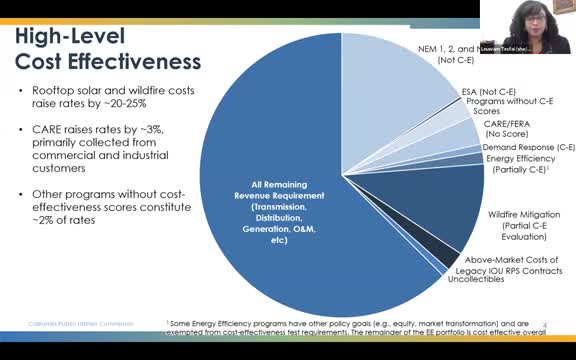California Commission Considers Reallocating Climate Credit to Aid Low-Income Customers
July 26, 2025 | Little Hoover Commission, Other State Agencies, Executive, California
This article was created by AI summarizing key points discussed. AI makes mistakes, so for full details and context, please refer to the video of the full meeting. Please report any errors so we can fix them. Report an error »

The Little Hoover Commission convened on July 24, 2025, to discuss critical issues surrounding California's electricity costs, focusing on the financial implications for consumers and potential strategies for rate reduction. The meeting highlighted a significant cost shift, estimated at $8 billion, which is contributing to rising electricity rates for customers. This shift accounts for approximately 20 to 25% of the overall rate increases, prompting urgent discussions on how to alleviate the financial burden on consumers.
One of the primary agenda items was the exploration of innovative ideas to reduce electricity costs. The Commission emphasized the need for funding programs that could offset these costs through non-ratepayer sources. Currently, there are no budget line items allocated for such initiatives, but the Commission recognized their importance in the ongoing conversation about electricity affordability.
Another key topic was the integration of wildfire mitigation plan costs into general rate cases. Historically, these costs have been addressed separately, but the Commission proposed a more cohesive approach to streamline the budgeting process and enhance transparency.
The discussion also delved into the state's climate credit, which is derived from the cap-and-trade program. The Commission presented various scenarios for reallocating this credit to better support low-income customers and those most affected by high electricity rates. Currently, customers receive about $120 in climate credits twice a year, but proposals were made to direct these funds specifically to low-income households and those without rooftop solar, particularly in California's hottest climate zones.
In a significant development, the Commission announced plans to open a rulemaking process aimed at optimizing the use of climate credits to improve customer affordability. This initiative will invite stakeholders to contribute ideas on how to effectively utilize these funds.
Commissioner Beyer raised concerns regarding potential biases in favor of construction by investor-owned utilities, questioning whether altering the rate of return could be a viable option for the Public Utility Commission. The implications of such a change on the utilities' ability to raise capital for infrastructure and wildfire mitigation were also discussed, indicating the complexity of balancing financial incentives with consumer protection.
The meeting concluded with a commitment to further explore these issues and engage stakeholders in the upcoming rulemaking process, signaling a proactive approach to addressing California's electricity cost challenges.
One of the primary agenda items was the exploration of innovative ideas to reduce electricity costs. The Commission emphasized the need for funding programs that could offset these costs through non-ratepayer sources. Currently, there are no budget line items allocated for such initiatives, but the Commission recognized their importance in the ongoing conversation about electricity affordability.
Another key topic was the integration of wildfire mitigation plan costs into general rate cases. Historically, these costs have been addressed separately, but the Commission proposed a more cohesive approach to streamline the budgeting process and enhance transparency.
The discussion also delved into the state's climate credit, which is derived from the cap-and-trade program. The Commission presented various scenarios for reallocating this credit to better support low-income customers and those most affected by high electricity rates. Currently, customers receive about $120 in climate credits twice a year, but proposals were made to direct these funds specifically to low-income households and those without rooftop solar, particularly in California's hottest climate zones.
In a significant development, the Commission announced plans to open a rulemaking process aimed at optimizing the use of climate credits to improve customer affordability. This initiative will invite stakeholders to contribute ideas on how to effectively utilize these funds.
Commissioner Beyer raised concerns regarding potential biases in favor of construction by investor-owned utilities, questioning whether altering the rate of return could be a viable option for the Public Utility Commission. The implications of such a change on the utilities' ability to raise capital for infrastructure and wildfire mitigation were also discussed, indicating the complexity of balancing financial incentives with consumer protection.
The meeting concluded with a commitment to further explore these issues and engage stakeholders in the upcoming rulemaking process, signaling a proactive approach to addressing California's electricity cost challenges.
View full meeting
This article is based on a recent meeting—watch the full video and explore the complete transcript for deeper insights into the discussion.
View full meeting
